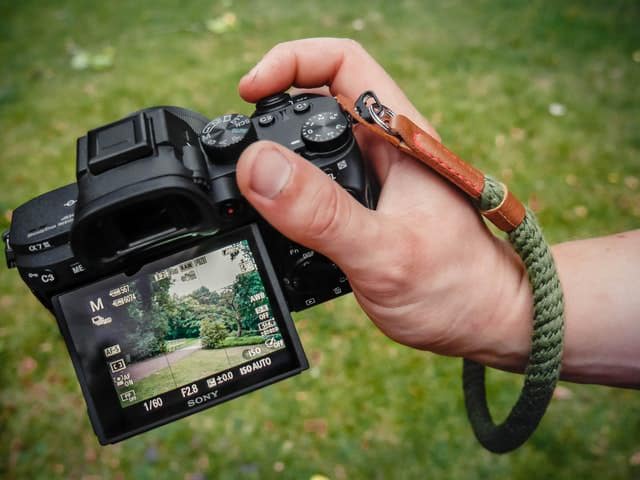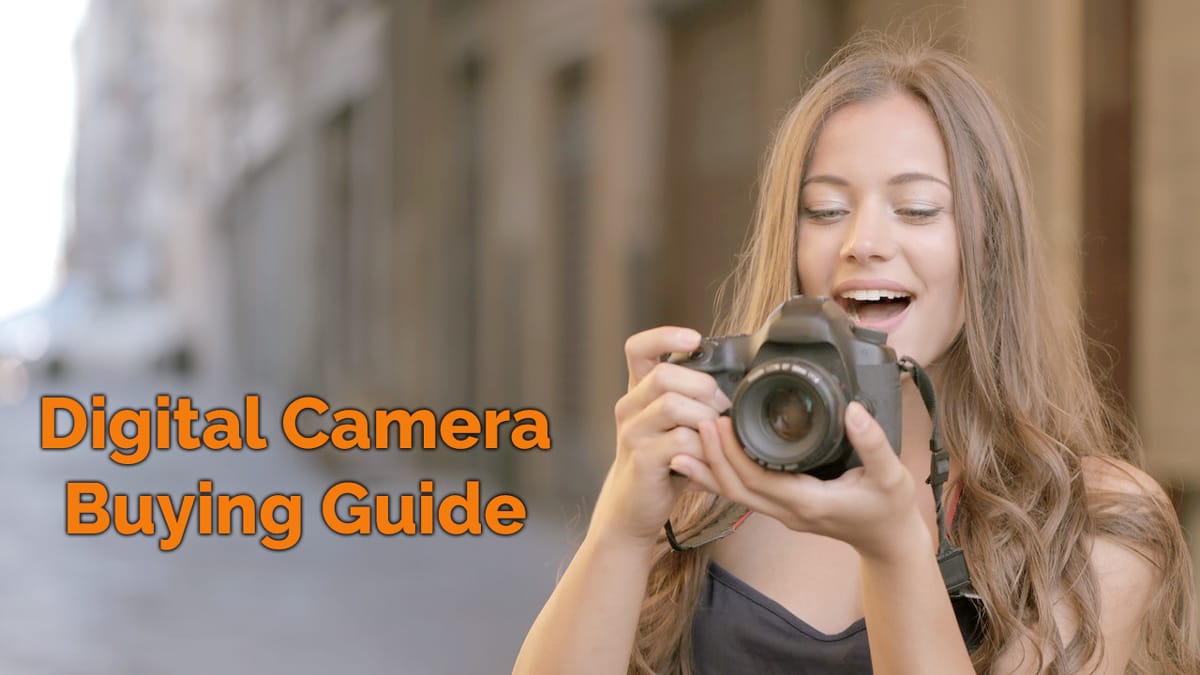Last updated on January 6th, 2022
In this article, we’ll be providing a digital camera buying guide for beginners. It’ll give you an idea of what to research before spending your hard-earned money.
Every photographer’s needs are unique — some do not mind a bulky body as long as the resolution is high, while some need a compact camera with Wi-Fi for family photos or vlogging.
This makes it important to prioritize the different features available from the hundreds of camera models out there, and then choose the camera that has most of them.
To land on the right choice of camera, you will need to consider the price range, the type of photography you wish to pursue, image sensor size, the extent of controls you want, and much more. As a result, we’re providing you our digital camera buying guide for beginners. It provides valuable tips on how to buy the best camera for your needs.
Digital Camera Buying Guide for Beginners
This list will help you get it right. And after you can check out our guide to buying a lens.
1. Budget

Obviously, the kind of choices available to you will be decided directly by how much you’re willing to spend. From small travel cameras that cost about $200 to professional bodies that are twenty times more expensive— there’s a lot to choose from.
As a starting point, think of a range with the minimum you’d like to spend and the maximum amount you can actually spend. A small range will help you narrow down your choices instead of a broad spectrum that might confuse you.
Your budget should also allow for lenses, a tripod, a camera bag, a memory card, and other accessories.
You can certainly begin with a kit lens and save money, but if you wish for a different lens, you will have to plan accordingly and widen your budget.
The general rule of thumb for a camera-lens budget is to assign one-third of it to your camera and the remainder for your lens(es).
You should also future-proof your budget. In case you want to be a professional photographer down the road, you may need a larger budget for professional-grade cameras and lenses.
2. Style of Photography

Some camera types are better suited for a particular style of shooting.
For example, suppose you typically shoot family photos or need a camera for vacations only. In that case, you may be happier with a compact point-and-shoot camera body or even just your smartphone.
On the other hand, enthusiast photographers who wish to get into landscape and serious travel photography will require a robust DSLR, preferably one that comes with weather sealing and lots of customizable dials like a Nikon D7500 or Canon 80D.
For portraits and street photography, you can consider a mirrorless camera with fast autofocus and touch controls. With modern technology, mirrorless cameras boast features like eye detection and animal AF, and even internal image stabilization.
Nifty features like these are vital because they not only help you nail the perfect shot but also make the camera more fun to use.
The smaller bodies like that of the Sony a6400 will help you travel light, and their fast hybrid focus systems will be great for videos and portraits.
Beginner-level DSLRs like the Nikon D5300 won’t match up with mirrorless cameras in this respect.
3. Type of Camera
Gone are the days when all cameras required you to load film in bulky box-like bodies. With options like DSLRs, mirrorless cameras, and point-and-shoot cameras that can fit into your pocket, you can choose the exact type of camera you want.
Should You Buy a DSLR or Mirrorless Camera?
The characteristic feature of DSLR cameras is their bigger size and optical viewfinder. You get to view the actual scene through the OVF and frame your composition, although this means that you won’t be able to get a digital representation of how your settings affect the final image.
DSLRs focus quickly through the viewfinder using phase-detect autofocus (AF) — especially flagship models like the Nikon D5 and Canon 1D X, which are excellent for sports and action photography. However, a significant disadvantage is their focusing speed through the back LCD in live view mode.
Because of contrast-detect AF, these are not a good option if you are into videography. You won’t be able to focus continuously on a moving subject or make smooth transitions from one subject to another. Apart from a few Canon cameras with Dual Pixel AF, most DSLRs will need you to focus through the OVF for greater speed and manually during video for good footage.
On the contrary, mirrorless cameras come with an EVF, which is an ‘electronic’ viewfinder. Since no mirror is required to reflect light into an OVF, mirrorless cameras are much more compact, with the downside of poorer battery life.
Further, the back LCD is much more useful here because of the hybrid AF, where the light directly comes to the sensor and the AF is a mix of contrast and phase detection. They might not match professional DSLRs for wildlife and sports photography, but the gap is closing swiftly.
Your final choice will come down to your preferences. For someone who wants the traditional experience of an OVF and doesn’t mind some extra weight, intermediate-level DSLRs beat mirrorless cameras in terms of build quality and AF tracking, but not so much in the video segment.
But if your budget does not let you go for mid-range DSLRs, mirrorless cameras are a better overall choice.
What About Point-and-Shoot Cameras?
An inexpensive option for people looking for their first camera, point-and-shoot bodies are tiny and easy to use.
Designed to be simple and portable, point-and-shoot cameras like the Sony Cybershot series or Canon PowerShot ELPH models do not offer full manual control. They also come with a fixed, non-interchangeable lens that can only zoom in and out.
Sometimes there’s no RAW support, too, like with DSLRs and mirrorless cameras, which means you only get JPG files to edit at the end.
For casual photography and people who do not care much about things like focus points and low-light noise, these are the best option. As mentioned earlier, your smartphone may be a better option.
4. Image Sensor Size
Each camera comes with an image sensor inside, which actually records the image and converts light into pixels. From medium format sensors — which are the biggest and most expensive — to 1-inch sensors found in compact point-and-shoot cameras, all these have their pros and cons.
Medium format sensors are about 5 cm in length, and the considerable area allows for a high megapixel count of up to 100 MP. Clearly, medium format cameras like the excellent Fujifilm GFX 100 are much more expensive and suitable mainly for professionals.
Next in line is the full-frame sensor, which matches the size of a 35 mm negative film in length and is found in enthusiast and flagship cameras like the Nikon D810 DSLR and the mirrorless Canon R6.
And then comes the crop sensor, also known as ‘APS-C,’ which stands for ‘Advanced Photo System Type-C’ and has a size of about 24 mm.
The main strength of a bigger sensor lies in its low-light performance and depth of field. Compared to an APS-C sensor, full-frame sensors will have less noise, and the background will be a bit more out of focus. With RAW format, full-frame sensors also give a bit more dynamic range and details in the shadows.
On the other hand, the smaller-sized APS-C sensors offer a more ‘zoomed in’ view, as if the photo of a full-frame sensor was cropped. This can be a useful trait for wildlife photographers, allowing them to get closer to the animals without a telephoto lens.
Yet another sensor type gaining popularity is the micro four-thirds, sitting just above the 1-inch sensors of compact cameras. With a size of around 17 mm, these sensors allow the camera to be relatively compact without losing much in terms of image quality and noise.
Models like the Panasonic Lumix GH-5 are a fan-favorite for both enthusiast photographers and video shooters because of their image quality, fast AF, and in-body image stabilization for hand-held shots.
5. Autofocus
The speed and reliability of a camera’s autofocus systems often decide how much you’ll enjoy shooting with it.
A slow AF that keeps hunting and pulling back and forth is something all photographers wish to avoid.
When selecting a DSLR, look for a camera that gives you a higher number of ‘cross type’ AF points. Compared to the standard AF points, cross-type points are quicker during the phase-detection process and more sensitive in low-light.
Further, suppose you feel that you will be using the back LCD or want to shoot videos. In that case, you should prefer DSLRs, which offer on-sensor phase-detect AF or hybrid AF, since the viewfinder is of no use in such cases. One great example would be the Canon 80D, an excellent combination of a traditional DSLR with an OVF and a point-and-shoot body with fast AF in live view.
6. Video Features
If you are serious about videography, there are a few extra features you should be on the lookout for.
Along with a smooth AF system through the LCD — which is more likely to be found in a mirrorless or a micro four-thirds camera — you will need the ability to shoot 4K, or at least 1080p up to 120 and 60 fps.
It will also be handy to have headphone and mic jacks to record audio correctly and use an external microphone.
A few cameras will also allow you to capture video using LOG profiles, like F-log and V-log. This format will preserve your footage quality and let you edit the colors and exposure for a cinematic look.
7. Design and Handle

A perfect camera should be a seamless part of your hands, something you enjoy carrying around and shooting with. Therefore, one of the most important things to do is go into a camera shop and try out a few cameras yourself.
Once you are holding the camera in your hands, try to judge the grip and decide if it’s big and comfortable enough for you or not. Also, pay attention to things like the viewfinder position and the dials.
Some people prefer shooting with their left eye to the viewfinder, in which case it’ll be better to have a camera where the LCD shuts off automatically to avoid making accidental changes with your nose pressed against the screen.
Furthermore, move your fingers around the camera and make sure you can reach the required buttons and dials easily.
A few other useful features to keep in mind are a tilting LCD — which is excellent for macros and low-angle perspective photos — and Wi-Fi, which lets you control your camera remotely and transfer images directly into your smartphone.
Choosing the right camera will require some trade-offs to be made. A more expensive DSLR might offer a magnesium alloy, weather-sealed body, but it will also be heavier. On the other hand, mirrorless cameras might give you a touchscreen LCD and a light body but may not offer in-camera image stabilization.
Conclusion
There are thousands of photography blogs and websites giving never-ending guides for buying a camera, but only you know which features matter to you the most.
Start by making a list of things you are looking for in a camera. This will help you significantly narrow down your choices and compare competing models. Body design, sensor size, autofocus system, viewfinder type, video features are all general areas with which you can begin your research.
In the end, do not forget to test the camera in-hand at a store. No review will come close to the feeling of your own hands and eyes while trying out the camera.
We hope you enjoyed our digital camera buying guide for beginners. And if you’re still researching to buy a lens, read our lens buying guide.

